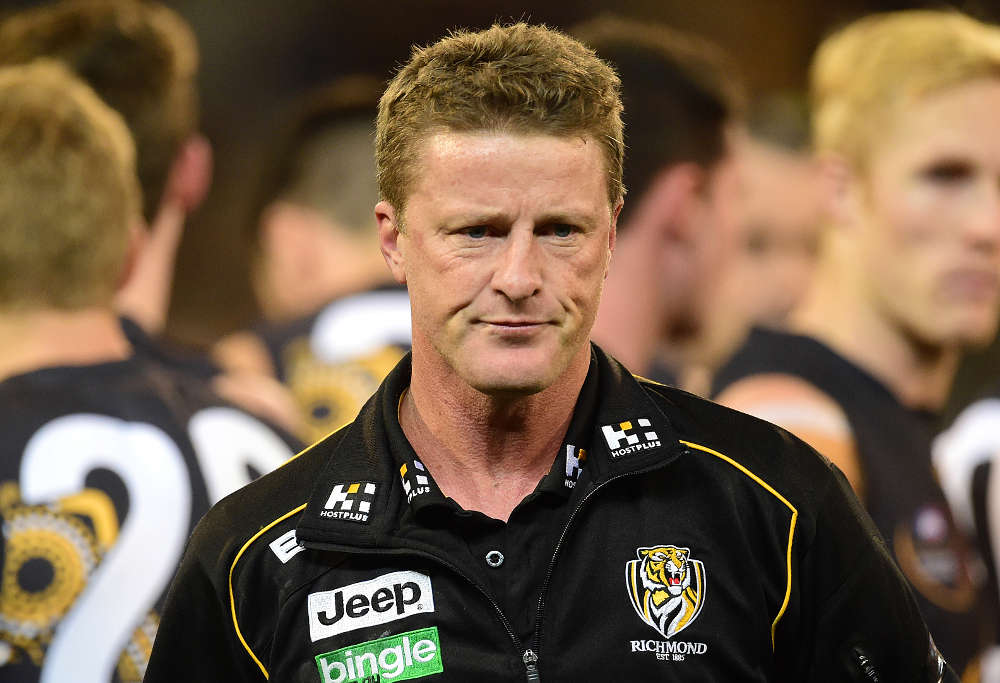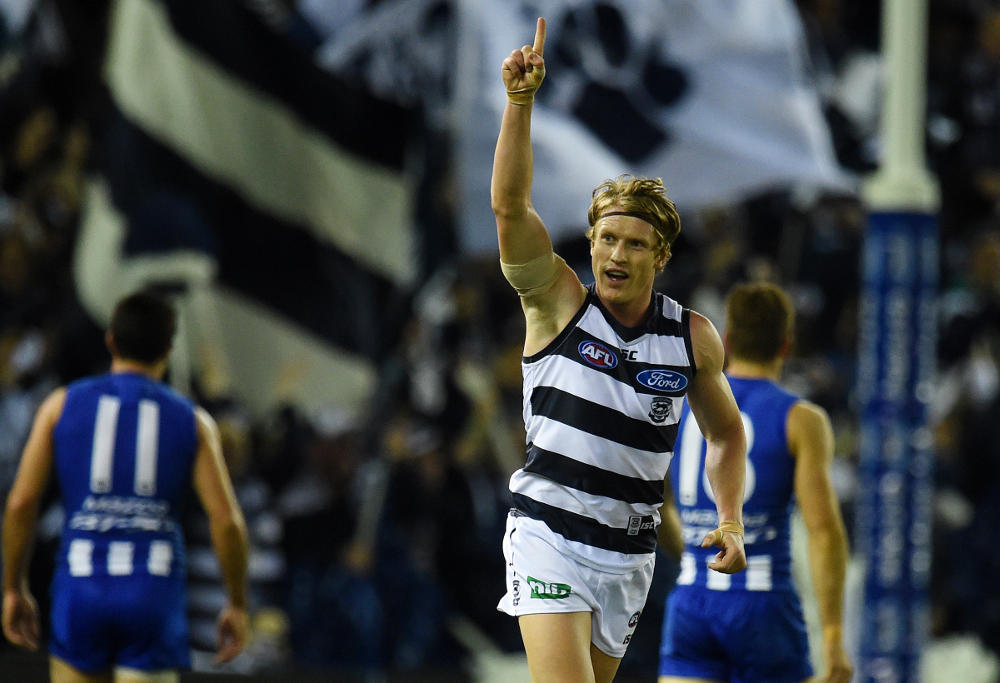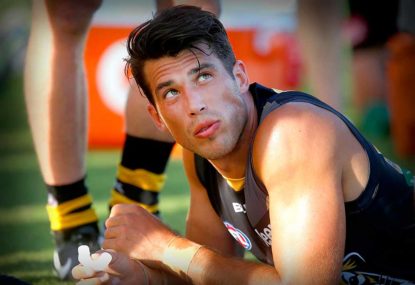Of all of last year’s shocks, Richmond falling from fringe top-four team to the bottom six was among the most surprising. Should we expect a rebound? After adding some more interesting pieces, there’s an optimistic case to be made.
Before we look forward, let’s take a brief look back.
For all the jokes levelled at Richmond and their penchant for finishing around the middle of the table, the 2016 Tigers should have built on three solid home-and-away seasons in the years prior. Richmond haven’t won a final since 2001, and spent the time between said win and 2013 outside of the finals looking in.
Between 2013 and 2015, the Tigers won 42 home-and-away season games – the fifth most in the league. Prior to the 2016 season they were a top-four fancy for most of the punditry. Richmond had three above average to elite midfielders, the best key defender, and one of the top handful of key forwards in the game. Their list continuity was beginning to reach top four aspirant levels.
An 8-14 season, therefore, was an almighty disappointment. There have been any number of post mortems on Richmond’s failings, but it came down to one common issue: indecision. In a season where quick movement of the ball was en vogue, the Tigers were among the most indecisive teams, particularly trying to escape from their back half. Their ball movement was stagnant, their driving half backs non-existent. All the other problems began here.
Over the course of the year, Richmond were a wash in most statistics: their contested possession differential was -0.3 per game, uncontested possession differential was +0.9, clearances were -1.1, kicks +2.0, handballs -1.4, marks +4.7. You get the picture.
The outlier? An inside 50 differential of -9.8 per game, with the Tigers only able to muster 45.7 inside 50s per game in their favour. It was the second-worst mark in the competition, ahead of just Fremantle on 45.5 per game. Winning and controlling the ball wasn’t a major problem. But using it was.
Remarkably, 8-14 was a generous summation of Richmond’s season. As we showed in this year’s numbers game, the Tigers only banked 5.8 wins – an outperformance of 2.2 wins. Their fall from 15 wins to eight was a little less stunning than Fremantle’s fall from 17 wins to four, and in any other season, Richmond’s decline would have been the biggest story in the game; in the preceding five years to last, just three teams saw their win totals fall by seven or more.
Prior to the 2016 season, the talk of the tabloid media was whether head coach Damien Hardwick should have his contract – due to expire at the end of the 2016 season – extended. One week prior to opening night, the Richmond board gave him an extra two years in charge. If he reaches the end of his tenure, Hardwick would have had nine years as the leader of Richmond’s football program.
Right now, that’s a big if.
This is an incalculably huge year for Richmond’s medium term future. Hardwick has two years left on his deal – never a good number, particularly for long-tenured coaches – their best player is heading for free agency, and their two superstar key position players Alex Rance and Jack Riewoldt are heading towards 30. Another flame out and all list and team management options could end up on the table.
Fortunately for Hardwick, his football department appears to have looked after him in the 2016 off season, with some astute additions that have the potential to revolutionise the way the Tigers go about their business. Their timing is hilariously Richmond, though, having made some moon shot deals in a year where more than three quarters of the competition hold genuine finals ambitions.

The Dangerfield effect
Patrick Dangerfield’s move to Geelong transformed their inside midfield group from one of the worst to one of the best. Dangerfield put together a stellar season, yes, but he showed what can happen when the magnets on a coach’s whiteboard are altered meaningfully from one year to next.
Dion Prestia isn’t Dangerfield, but he is an excellent inside midfielder with room to grow. Josh Caddy is also no Dangerfield, but is a known quantity with a pedigree of above average inside play. But adding these two bullocking midfielders should create a similar effect for the Tigers.
Prestia cost the Tigers a first round pick, the first time Richmond have traded away their top draft selection in their current run. His first four years at Gold Coast hinted at his potential, before it came to the surface in year five. Prestia won 8.5 clearances and 13.6 contested possessions per game for the Suns in 2015 – marks that were second and ninth in the league, respectively. The kicker: it was only an eight-game season for the pint-sized (for a modern midfield) midfielder, with a meniscus issue in his knee gradually deteriorating and costing him two-thirds of a season. It flared up again in 2016, although he managed 14 games before succumbing in Round 16.
The Tigers have traded for an old school inside-dominant player, with strong ability below the knees and a keen eye for the opposition ball carrier. Prestia is comfortable in space too, but does his best work in congestion. And with the second week of the preseason confirming teams are looking to handball more than last year, it looks an astute addition on paper.
Caddy, who it would appear fell into Richmond’s lap as the Cats tried to clear salary cap and list space for a player who never materialised, has more utility but less depth of skill.

His best season came in 2015, when paired with Geelong captain Joel Selwood on the inside. When Dangerfield met Selwood, three was a crowd and Caddy was squeezed out of a full-time midfield post. He spent much of his season on Geelong’s half forward line, not quite a forward, not quite a midfielder.
Prestia is a certainty for Richmond’s Round 1 line up, while Caddy is a near certainty. Why? Because of the flow-on effects of their injection into the team.
The Tigers had three great midfielders at the start of 2016: Dustin Martin, Trent Cotchin and Brett Deledio. Their supporting cast was B-grade: Shane Edwards, Shaun Grigg, Anthony Miles, Taylor Hunt and the like. Talent more suited to the midfield in Nick Vlaustin and Brandon Ellis was shifted back a position line or two to support the thinnest part of Richmond’s list. The insertion of Caddy and Prestia completely changes this dynamic.
Deledio is gone, but Martin and Cotchin remain. The go to centre square line up must now be Martin, Prestia and Cotchin. Caddy becomes the fourth man, generally starting outside the square but spending plenty of time running through centre, too. That pushes Edwards permanently to the half forward line – arguably a better spot for him – and Grigg to the fifth midfielder spot coming off a wing.
Hunt will likely find himself on the outer, starting on the bench or out of the team all together depending on what Hardwick decides to do with Vlaustin and Ellis. Vlaustin played plenty of time as a bonafide midfielder last Friday, even getting to play in the forward line for patches in Richmond’s unusual resting forward scheme (more on that in a bit).
The biggest beneficiary here is Cotchin, who could be a free man once more rather than being asked to do too much of the heavy lifting. In his now-Brownlow year, Cotchin was given more freedom by Hardwick to float around and play link man, rather than winning his own ball and dishing it out to others on the outside. Expect his role to morph back into something like this in 2017.
One expects Dustin Martin will enjoy having two teammates alongside him bashing and crashing fools, too.
Let Jack be Jack
The other material change to Richmond’s personnel is a subtraction, namely the departure of Ty Vickery.
A common, recurring, almost nuisance refrain of Richmond fans in recent years has been Jack Riewoldt’s role in the Tigers’ forward line. Each year, it seems he creeps further and further from the goal square in an effort to provide Richmond’s flaky half back line an outlet kick option. Vickery’s role in the side as the second ruckman/second forward saw him spend most of his time as the deepest forward option. Riewoldt was caught in no man’s land.
It’s a modern football miracle that Riewoldt has been able to maintain his goal kicking output around the top tier of the competition in these circumstances. Last year was the first time since 2009 Riewoldt kicked less than 50 goals in a season, but when you consider the Tigers only got the ball inside the attacking stripe 45 times a game there’s a clear reason for this.
The chart below shows the combined scoring shots (goals and behinds) of Riewoldt and Vickery from the time Riewoldt cemented his status as the Tigers’ key forward.

In Jack’s monster year, 2010, he hit the scoreboard 5.3 times per game to Vickery’s 0.4 times per game. In the year since, Vickery’s scoring shots per game have increased and Riewoldt’s have fallen, but the two have essentially combined for 6.5 scoring shots per game every season. As Vickery was trusted with a bigger role in the offence, Riewoldt’s influence on Richmond shrank.
It affected where he has been taking possession of the ball. In the past two seasons, Riewoldt has taken just under half of his marks inside Richmond’s forward 50, down from well in excess of 60 per cent and even 70 per cent between 2010 and 2014.
Now Vickery is gone, the keys have surely been turned back over to Riewoldt to run the show and dictate terms inside forward 50.
He heads up a fleet that is likely to feature a plethora of mid-sized and small options, including Daniel Rioli (who looked a guy ready to take a huge leap in his second year on Friday), Sam Lloyd, and any of Oleg Markov, Jason Castagna (Can’t Stand Ya) and Dan Butler who may see some time. Ben Griffiths looks to be the second tall option.
Then there’s the Richmond company policy of always rotating one of their midfielders through the forward line. Martin, Cotchin and Deledio have all spent time as one on one full forwards under Hardwick, and one would expect Caddy to join that party. Vlaustin also spent some time in the forward line, while Shane Edwards and Shaun Grigg could also see some action given their roles through the middle may be lessened under the new team hierarchy.
It’s an interesting proposition. But with Riewoldt given the space to be Riewoldt, one expect the Tigers to fare better than they did last year at the pointy end of the ground.
And there’s more…
The other reasons to be positive are more exogenous. Richmond’s fixture situation has changed for the better, with this year’s numbers game pegging their slate as the second least difficult on the year. Their average opponent has a Pythagorean win percentage from 2016 of 48.7 per cent, second only to North Melbourne (47.5 per cent). It’s a fall of 6.9 per cent from 2016, the third largest fall in the league.
Richmond have just one top eight double up; the Giants, whom no one is beating twice this season regardless of pedigree. There’s a strong chance the Tigers double up on the teams that finish 17th and 18th in Carlton and Brisbane, too. Games against St Kilda and Fremantle could become significant in deciding the finishing order around the mid-table.
Their 11 games at the MCG are the third most in the league (behind Collingwood and Melbourne, and equal with Hawthorn), while they play four non-Victorian teams on the game’s biggest ground.
We also can’t talk about Richmond without at least mentioning Jedi Knight Alex Rance. The Tigers’ defensive Swiss army knife is far and away the best defensive player in the game, able to take players regardless of height, size, agility or preferred playing style and neutralise them. Richmond were blown out five times last season – without Rance one assumes this would have been a larger number.
He will helm a defensive unit that has undergone some churn in recent years, and looks set to churn once more with the departure of Chris Yarran and move of Vlaustin to Richmond’s midfield. Troy Chaplin has retired, while Dylan Grimes and Bachar Houli spent six and ten games on the sidelines last season. Kamdyn McIntosh looms as a candidate for a half back role, with his rangey legs and height a required skill set to play in what is emerging as the most important tactical line in the game.
So long as Rance is in place, the Tigers should have what it take to be at worst an average defensive team. The shoulds, coulds and ifs for this team now all come down to one man.
Damien Hardwick
Despite it all, the same big question hangs over this Richmond season as it did the last: does Damien Hardwick have it in him to, as Cam Rose said so well last year, release the guns?
For all of last year, the Tigers were playing an inferior game style that had been ripped to shreds by opposition coaches trying to counter Alastair Clarkson’s Hawks for years. The slow, careful movement of the ball from half back to half forward was death, unless you were Hawthorn itself because that team cannot be killed.
As Cam said last year, the Tigers of the recent past rose up the ladder on the back of a fast, attacking game style, only to beat themselves in the 2013 elimination final. It seems hard to believe after last season, but the 2012 and 2013 Richmond team scored 98 points per game (with Offensive Efficiency Ratings of +7.1 and +5.6, respectively).
Hardwick changed tack, focussing on ball control to the detriment of what made Richmond a contender. For a while it worked just fine, but last year it was exposed.
The Chris Yarran trade was certainly designed to support Richmond’s stodgy half back line, and the absence of Houli for much of the season didn’t help matters. But even then, there was a clear, transparent tactical bent towards slow play, short kick-and-mark and ball control. Hardwick and his senior players have said it in the past: we want to play like Hawthorn.
No one plays like Hawthorn. Not even Hawthorn, who change things up every year. A repeat dose, even with the changes to Richmond’s best 22 and more amenable fixture, will yield the same results.
Fortunately for Richmond fans, there were plenty of signs that Hardwick has overhauled his game plan in the offseason in the club’s first preseason hit out against (an admittedly weakened) Adelaide. There was a greater willingness to run and carry from behind centre, instead of the 15-metre kicks to one on one contests. There was a definite desire to kick long and deep from forward of centre, rather than chipping around and looking for a hit up lead. There was a clear intent to run out of stoppages and link with handballs, rather than conservatively moving backwards and sideways.
It showed up in Richmond’s kick to handball ratio for the game: 1.11, down from the second-to-Hawthorn 1.31 of 2016. The aforementioned small forward fleet injected a pace which hasn’t been sighted at Tigerland for years. It’s one week, but right now that’s all we have to go on and the signs were positive.
What does it all mean? There are more than a few reasons for the Tigers to feel positive about the year ahead. It might not translate into an immediate return to finals football, but if enough breaks Richmond’s way they are well in the hunt. Something approaching 11 wins and a positive percentage is the benchmark.
The biggest puzzle piece all looks set to be coach Hardwick himself. After last year’s debacle, almost his entire coaching panel was wiped out in a restructure. Accountability for Richmond’s on-field performance has been placed squarely on his shoulders. Another year of floundering, particularly after the moves Richmond’s off field program made in the off season, could spell all manner of change in the 2017 off season.
































































































